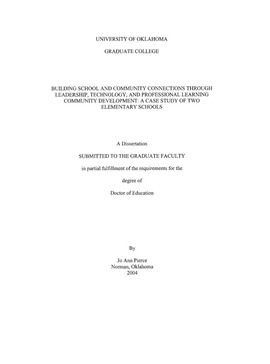| dc.contributor.advisor | O'Hair, Mary John, | en_US |
| dc.contributor.author | Pierce, Jo Ann. | en_US |
| dc.date.accessioned | 2013-08-16T12:19:24Z | |
| dc.date.available | 2013-08-16T12:19:24Z | |
| dc.date.issued | 2004 | en_US |
| dc.identifier.uri | https://hdl.handle.net/11244/729 | |
| dc.description.abstract | As in any other profession, schoolteachers, principals, and other administrators need a vision to help them toward their goals. The intent of this research was to examine schools that have connected their vision for technology and student learning with parents and the community. | en_US |
| dc.description.abstract | This multiple site case study shared through documents, a survey, and interviews how two elementary schools in the process of becoming professional learning communities facilitate connections with the community. Results indicate how schools facilitate technology, student achievement, leadership practices, parent involvement, and community groups in cultivating school and community connections. Conclusions, recommendations, and implications for leadership, technology, and professional learning community development are provided. | en_US |
| dc.description.abstract | This multiple site case study describes how two elementary schools in a south central state are building school and community connections through leadership, technology, and professional learning community development. The principals of both schools have completed a professional development program designed to assist administrators in developing professional learning communities at the schools they lead. Upon successful completion of the program principals and superintendents are provided opportunities for additional funding through a statewide technology trust. In August 2003 the two schools participating in this study were two of twenty-one schools receiving grants. The twenty-one schools would be responsible for implementing three of the ten practices of the IDEALS High Achieving School Model to become a professional learning community using their new technology as a tool. This research is based on Practice 8: School and Community Connections, one of the three practices chosen by schools participating in this research during the 2003--2004 school year. They must connect with families and communities in many ways. They must involve families and communities in the work of the school while simultaneously, involving their schools in the work of their families and communities. | en_US |
| dc.format.extent | xvii, 249 leaves : | en_US |
| dc.subject | Education, Elementary. | en_US |
| dc.subject | Community and school Oklahoma Case studies. | en_US |
| dc.subject | Education, Administration. | en_US |
| dc.subject | Community and school Case studies. | en_US |
| dc.title | Building school and community connections through leadership, technology, and professional learning community development: A case study of two elementary schools. | en_US |
| dc.type | Thesis | en_US |
| dc.thesis.degree | Ed.D. | en_US |
| dc.thesis.degreeDiscipline | Department of Educational Leadership and Policy Studies | en_US |
| dc.note | Source: Dissertation Abstracts International, Volume: 65-02, Section: A, page: 0372. | en_US |
| dc.note | Major Professor: Mary John O'Hair. | en_US |
| ou.identifier | (UMI)AAI3122313 | en_US |
| ou.group | Jeannine Rainbolt College of Education::Department of Educational Leadership and Policy Studies | |
